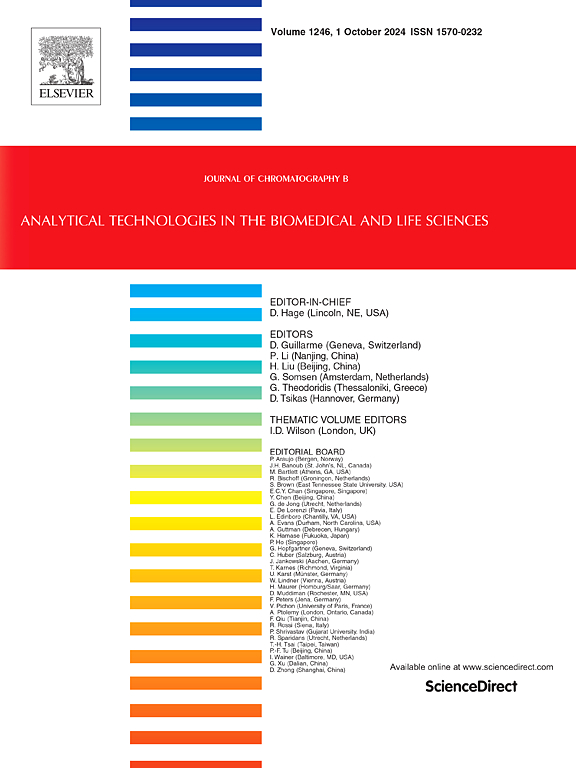四神丸通过NLRP3/ASC/Caspase-1信号通路缓解溃疡性结肠炎:UPLC-Q-TOF/MS、网络药理学、分子对接、体内实验等综合验证
IF 2.8
3区 医学
Q2 BIOCHEMICAL RESEARCH METHODS
引用次数: 0
摘要
“四神丸”是治疗脾肾阳虚型腹泻的传统中药制剂,在治疗溃疡性结肠炎(UC)方面具有显著的临床疗效。然而,SSP对UC的治疗作用的生物活性化合物和潜在机制仍然没有得到充分的阐明。目的通过超高效液相色谱-四极杆飞行时间串联质谱(UPLC-Q-TOF/MS)、网络药理学、分子对接、动物实验等手段,系统阐明SSP治疗UC的生物活性成分及作用机制。方法采用UPLC-Q-TOF/MS对其化学成分进行表征。网络药理学用于预测UC治疗中SSP的主要化学成分和核心靶点,分子对接用于评估其结合亲和力。随后,建立了UC大鼠模型,并使用一系列技术进行了机制验证,包括苏木精和伊红(HE)染色、透射电镜、免疫荧光染色、Western blotting、逆转录聚合酶链反应(RT-PCR)和酶联免疫吸附试验(ELISA)。结果在该研究中,共鉴定出79种化学成分。通过网络药理学分析,确定了柠檬酸、丁香酚、大豆苷元、7-羟基香豆素、4-羟基香豆素、黄芪苷和十八烯酸是其核心化学成分,并确定了Caspase-1和IL-1β为主要靶点。分子对接研究表明,这些核心靶点与化学成分之间具有很强的亲和力。体内实验表明,SSP可显著减轻UC大鼠的体重减轻症状,提高疾病活动指数(DAI),减轻结肠组织损伤。此外,SSP还降低了结肠组织中NLRP3、ASC和Caspase-1的蛋白表达水平,下调了结肠组织中IL-18和IL-1β的血清水平和mRNA表达。结论sssp可能通过调节NLRP3/ASC/Caspase-1信号通路,减轻肠道炎症反应,促进肠黏膜屏障修复,从而发挥其治疗UC的作用。本文章由计算机程序翻译,如有差异,请以英文原文为准。

Sishen pill alleviates ulcerative colitis via the NLRP3/ASC/Caspase-1 signaling pathway: Comprehensive validation through UPLC-Q-TOF/MS, network pharmacology, molecular docking, and in vivo experiments
Background
The “Sishen Pill” (SSP) is a traditional Chinese medicinal formulation traditionally employed in the treatment of diarrhea attributed to spleen-kidney yang deficiency, and it has exhibited notable clinical efficacy in managing ulcerative colitis (UC). Nevertheless, the bioactive compounds and the underlying mechanisms by which SSP exerts its therapeutic effects on UC remain inadequately elucidated.
Objectives
This study sought to systematically elucidate the bioactive constituents and the mechanism of action of SSP in the treatment of UC through the application of ultra-high-performance liquid chromatography-quadrupole time-of-flight tandem mass spectrometry (UPLC-Q-TOF/MS), network pharmacology, molecular docking, and animal experimentation.
Methods
The chemical constituents of SSP were characterized using UPLC-Q-TOF/MS. Network pharmacology was employed to predict the principal chemical constituents and core targets of SSP in the context of UC treatment, while molecular docking was utilized to assess their binding affinities. Subsequently, a rat model of UC was established, and mechanistic validation was performed using a range of techniques, including hematoxylin and eosin (HE) staining, transmission electron microscopy, immunofluorescence staining, Western blotting, reverse transcription-polymerase chain reaction (RT-PCR), and enzyme-linked immunosorbent assay (ELISA).
Results
In this study, a total of 79 chemical constituents were identified in SSP. Through network pharmacology analysis, Citric acid, Eugenol, Daidzein, 7-Hydroxycoumarin, 4-Hydroxycoumarin, Astragalin, and Octadecenoic acid were determined to be the core chemical constituents, with Caspase-1 and IL-1β identified as the primary targets. Molecular docking studies indicated a strong affinity between these core targets and chemical constituents. In vivo experiments demonstrated that SSP significantly mitigated weight loss symptoms, enhanced the disease activity index (DAI), and reduced colonic tissue damage in UC rats. Furthermore, SSP was found to decrease the protein expression levels of NLRP3, ASC, and Caspase-1 in colonic tissue, as well as downregulate serum levels and mRNA expression of IL-18 and IL-1β in colonic tissue.
Conclusions
SSP may exert its therapeutic effects on UC by modulating the NLRP3/ASC/Caspase-1 signaling pathway, thereby attenuating intestinal inflammatory responses and facilitating the repair of the intestinal mucosal barrier.
求助全文
通过发布文献求助,成功后即可免费获取论文全文。
去求助
来源期刊

Journal of Chromatography B
医学-分析化学
CiteScore
5.60
自引率
3.30%
发文量
306
审稿时长
44 days
期刊介绍:
The Journal of Chromatography B publishes papers on developments in separation science relevant to biology and biomedical research including both fundamental advances and applications. Analytical techniques which may be considered include the various facets of chromatography, electrophoresis and related methods, affinity and immunoaffinity-based methodologies, hyphenated and other multi-dimensional techniques, and microanalytical approaches. The journal also considers articles reporting developments in sample preparation, detection techniques including mass spectrometry, and data handling and analysis.
Developments related to preparative separations for the isolation and purification of components of biological systems may be published, including chromatographic and electrophoretic methods, affinity separations, field flow fractionation and other preparative approaches.
Applications to the analysis of biological systems and samples will be considered when the analytical science contains a significant element of novelty, e.g. a new approach to the separation of a compound, novel combination of analytical techniques, or significantly improved analytical performance.
 求助内容:
求助内容: 应助结果提醒方式:
应助结果提醒方式:


